Related Research Articles
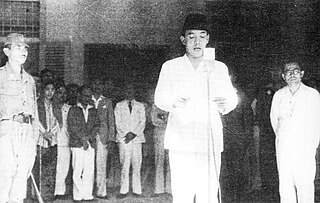
The Indonesian National Revolution also known as the Indonesian War of Independence, was an armed conflict and diplomatic struggle between the Republic of Indonesia and the Dutch Empire and an internal social revolution during postwar and postcolonial Indonesia. It took place between Indonesia's declaration of independence in 1945 and the Netherlands' transfer of sovereignty over the Dutch East Indies to the Republic of the United States of Indonesia at the end of 1949.

Sukarno was an Indonesian statesman, orator, revolutionary, and nationalist who was the first president of Indonesia, serving from 1945 to 1967.

The Communist Party of Indonesia was a communist party in the Dutch East Indies and later Indonesia. It was the largest non-ruling communist party in the world before its violent disbandment in 1965. The party had two million members in the 1955 elections, with 16 percent of the national vote and almost 30 percent of the vote in East Java. During most of the period immediately following the Indonesian Independence until the eradication of the PKI in 1965, it was a legal party operating openly in the country.
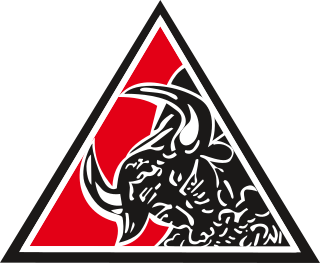
The Indonesian National Party was the name used by several nationalist political parties in Indonesia from 1927 until 1973. The first PNI was established by future President Sukarno. After independence, the new PNI supplied a number of prime ministers, and participated in the majority of cabinets in the 1950s and 1960s. The party was fused into the Indonesian Democratic Party in 1973. In the years following the reforms of the late 1990s, a number of parties claiming to be the continuation of previous PNIs stood in elections, but gained only a handful of seats.
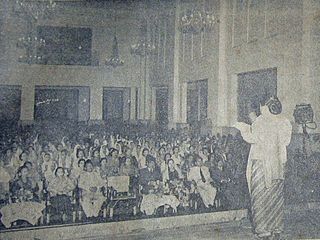
Gerwani was a women's organization founded as Gerwis in Semarang, Central Java, on 4 June 1950.
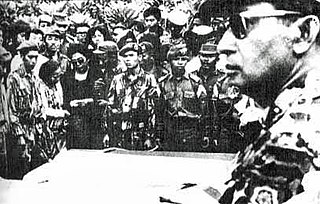
Indonesia's transition to the New Order in the mid-1960s ousted the country's first president, Sukarno, after 22 years in the position. One of the most tumultuous periods in the country's modern history, it was the commencement of Suharto's 31-year presidency.
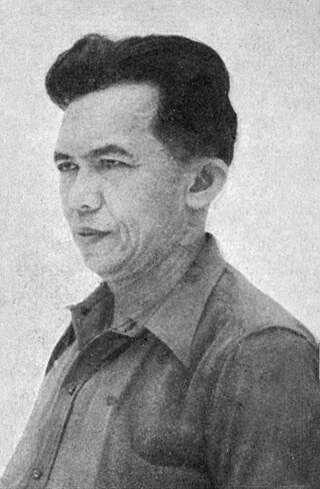
Tan Malaka was an Indonesian teacher, Marxist, philosopher, founder of Struggle Union and Murba Party, independent guerrilla and spy, Indonesian fighter, and national hero. Tempo credited him as "Father of the Republic of Indonesia".

The Council of Indonesian Muslim Associations Party, better known as the Masyumi Party, was a major Islamic political party in Indonesia during the Liberal Democracy Era in Indonesia. It was banned in 1960 by President Sukarno for supporting the PRRI rebellion.

The Madiun Affair, known locally as the Communist Party of Indonesia rebellion of 1948, was an armed conflict between the government of the self-proclaimed Republic of Indonesia and the left-wing opposition group Front Demokrasi Rakyat during the Indonesian National Revolution. The conflict began on September 18, 1948, in Madiun, East Java, and ended three months later when most FDR leaders and members were detained and executed by TNI forces.

Large-scale killings and civil unrest primarily targeting members of the Communist Party (PKI) were carried out in Indonesia from 1965 to 1966. Other affected groups included alleged communist sympathisers, Gerwani women, trade unionists, ethnic Javanese Abangan, ethnic Chinese, atheists, so-called "unbelievers", and alleged leftists in general. According to the most widely published estimates at least 500,000 to 1.2 million people were killed, with some estimates going as high as two to three million. The atrocities, sometimes described as a genocide or politicide, were instigated by the Indonesian Army under Suharto. Research and declassified documents demonstrate the Indonesian authorities received support from foreign countries such as the United States and the United Kingdom.
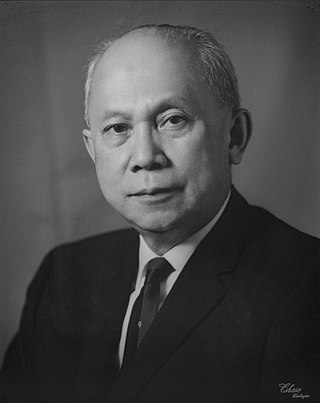
Lambertus Nicodemus Palar, also known as Babe Palar, represented the Republic of Indonesia in various diplomatic positions most notably as the first Indonesian representative to the United Nations. He also held ambassadorships in India, West Germany, the Soviet Union, Canada, and the United States. He was the son of Gerrit Palar and Jacoba Lumanauw.
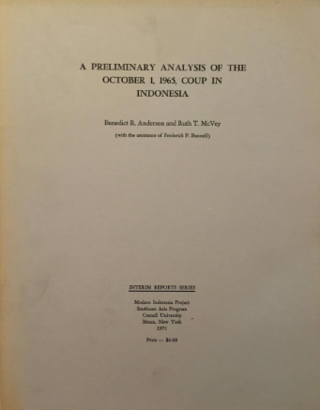
A Preliminary Analysis of the October 1, 1965, Coup in Indonesia, more commonly known as the "Cornell Paper", is an academic publication detailing the events of an abortive coup d'état attempt by the self-proclaimed September 30 Movement, produced on January 10, 1966. The study was written by Benedict Anderson and Ruth McVey, with the help of Frederick Bunnell, using information from various Indonesian news sources. At the time of writing, the three were members of Cornell University's network of graduate students and scholars on Southeast Asia.
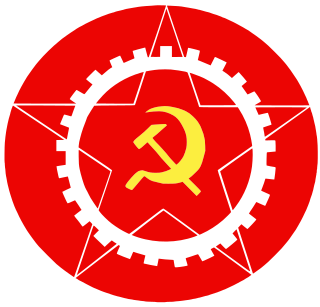
The Labour Party of Indonesia was a political party in Indonesia.
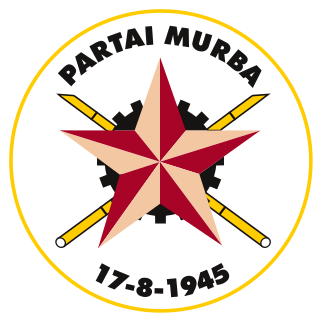
Murba Party was a 'national communist' political party in Indonesia. The party was founded by Tan Malaka, Chairul Saleh, Sukarni and Adam Malik in 1948. The history of the party was largely intertwined with that of the powerful Communist Party of Indonesia (PKI). Initially relations between PKI and the Murba Party were fluid, but gradually the two parties developed into each other's arch-enemies. The Murba Party continued to exist under the New Order, but was merged into the Indonesian Democratic Party in 1973.

The Central All-Indonesian Workers Organization was the largest trade union federation in Indonesia. Founded during the period of the country's independence in the late 1940s, the federation grew rapidly in the 1950s. It was initially formed with loose connections to the Communist Party of Indonesia (PKI) and with members from other parties, but over time, the PKI became dominant in the organisation. With the introduction of President Sukarno's guided democracy in the late 1950s, SOBSI was formally recognised and given a place in the national decision-making structures. In the 1960s, SOBSI came into conflict with the Army, whose officers controlled the country's state enterprises. After the 1965 coup that subsequently produced Suharto's New Order regime, SOBSI was declared illegal, its members killed and imprisoned and most of the leadership executed.

Wikana was an Indonesian minister and independence leader. He was one of the youths who forced Sukarno and Hatta to declare independence immediately after the surrender of the Japanese. He was the first Indonesian Minister of Youth and Sport. He was a member of the Indonesian Communist Party. Sometime after the 1965 coup d'état attempt, he was arrested and went missing. It is supposed that he was one of the assassinated in the Indonesian mass killings of 1965–66.
Censorship in Indonesia has varied since the country declared its independence in 1945. For most of its history the government of Indonesia has not fully allowed free speech and has censored Western movies, books,films, and music as well. However, partly due to the weakness of the state and cultural factors, it has never been a country with full censorship where no critical voices were able to be printed or voiced.
The Indonesia Party, better known as Partindo, was a nationalist political party in Indonesia that existed before independence and was revived in 1957 as a leftist party.
Lintong Mulia Sitorus, in pre-1948 spelling Lintong Moelia Sitoroes, was an Indonesian intellectual, writer, translator, lawyer, and Socialist Party of Indonesia politician. He was a key follower of the independent-minded Indonesian nationalist Sutan Sjahrir in the 1940s and 1950s.
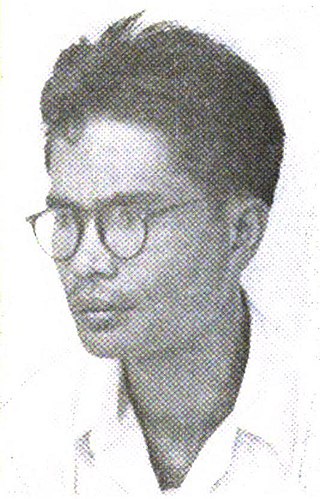
Peris Pardede (1918–1982) was an Indonesian politician who was a key figure in the Communist Party of Indonesia during the Sukarno era. He held various roles, including editor of the party magazine Bintang Merah, representative of the party in the Provisional House of Representatives and the House of Representatives throughout the 1950s and early 1960s, and Politburo candidate in 1965. After the party was banned in 1965, he was put on trial and spent his final decades as a political prisoner of the Suharto regime.
References
- 1 2 3 4 5 6 Hindley, Donald. The Communist Party of Indonesia, 1951-1963 . Berkeley: University of California Press, 1964. pp. 196-197
- ↑ Lucas, Anton. What Makes an Activist? Three Indonesian Life Histories
- ↑ McGlynn, John. Indonesia in the Soeharto Years: Issues, Incidents, and Images . Jakarta: Lontar Foundation, 2007. p. 15
- ↑ Latif, Yudi. Indonesian Muslim Intelligentsia and Power . Singapore: Institute of Southeast Asian Studies, 2008. p. 301
- ↑ Crouch, Harold A. The Army and Politics in Indonesia. Politics and international relations of Southeast Asia . Ithaca, N.Y.: Cornell University Press, 1978. p. 165
- ↑ Hunter, Helen-Louise. Sukarno and the Indonesian Coup: The Untold Story . Westport, Conn. [u.a.]: Praeger Security International, 2007. 95
- ↑ McGregor, Katharine E. History in Uniform: Military Ideology and the Construction of Indonesia's Past . ASAA Southeast Asia publications series. Singapore: NUS Press, 2007. p. 230
- ↑ Choi, Jungug. Governments and Markets in East Asia: The Politics of Economic Crisis . London: Routledge, 2006. p. 29
- ↑ Lev, Daniel S., and Ruth McVey. Making Indonesia: [Essays on Modern Indonesia in Honor of George McT. Kahin] . Studies on Southeast Asia, no. 20. Ithaca, N.Y.: Southeast Asia Program, Cornell University, 1996. p. 131